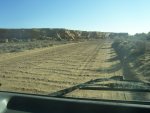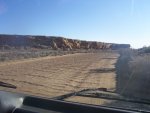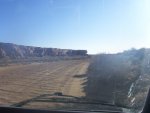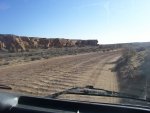Took the truck into Chaco Canyon over the weekend. 16 miles of the worse washboard I've ever seen and I've driven on a fair amount of it. Chacoans were known as exacting road builders but they must have taken their road grader with them when they left in 1150 and nobody has bothered to take another one down there. Experimented with a couple of methods. 23+ mph was relatively smooth. I think the tires were only hitting the tops of the ridges since the speed was high enough that there wasn't time for the wheels to drop into the troughs. However there were two problems. 1. I think it was unsafe due to such little road contact between tire and road surface. 2.--this was the big one--if you had to slow down while on the washboard, once you dropped below about 21 mph, the shaking and hammering was horrific down to about 1 mph. The only way it would have been feasible was if you could hit the washboard at that speed and maintain that speed until you came off it onto smooth road. Not an option on this road due to tight turns and traffic. So, I ended up using the other option, granny low with the speed so slow it wasn't registering on the speedometer. It was like driving over a continuous serious of speed bumps about 18" apart.
The washboard is not like your typical dirt road with two ruts of washboard and smoother dirt outside the ruts. This washboard is uniform from berm to berm and frequently 4-6" tall. There were places where the road was clay and hard packed but most of it was loose dirt/sand and washboarded. There were a few places with about 1' of sand on the end of the washboard before the ditch of sand but in most of those places you could see where people were running with their right tires on that narrow lip and got sucked off into the sand ditch and stuck. The conditions are a result of very high traffic flow due to the popularity of the destination and the fact that the Native Americans own the road into the park and don't want to keep it useable since they don't like the fact that the park exists.
Are there techniques I didn't figure out. There are one or two houses on the road about halfway out. A local past us heading out as we were heading in. It sounded like every bolt and nut on his truck was rattling as he headed out.
The washboard is not like your typical dirt road with two ruts of washboard and smoother dirt outside the ruts. This washboard is uniform from berm to berm and frequently 4-6" tall. There were places where the road was clay and hard packed but most of it was loose dirt/sand and washboarded. There were a few places with about 1' of sand on the end of the washboard before the ditch of sand but in most of those places you could see where people were running with their right tires on that narrow lip and got sucked off into the sand ditch and stuck. The conditions are a result of very high traffic flow due to the popularity of the destination and the fact that the Native Americans own the road into the park and don't want to keep it useable since they don't like the fact that the park exists.
Are there techniques I didn't figure out. There are one or two houses on the road about halfway out. A local past us heading out as we were heading in. It sounded like every bolt and nut on his truck was rattling as he headed out.




